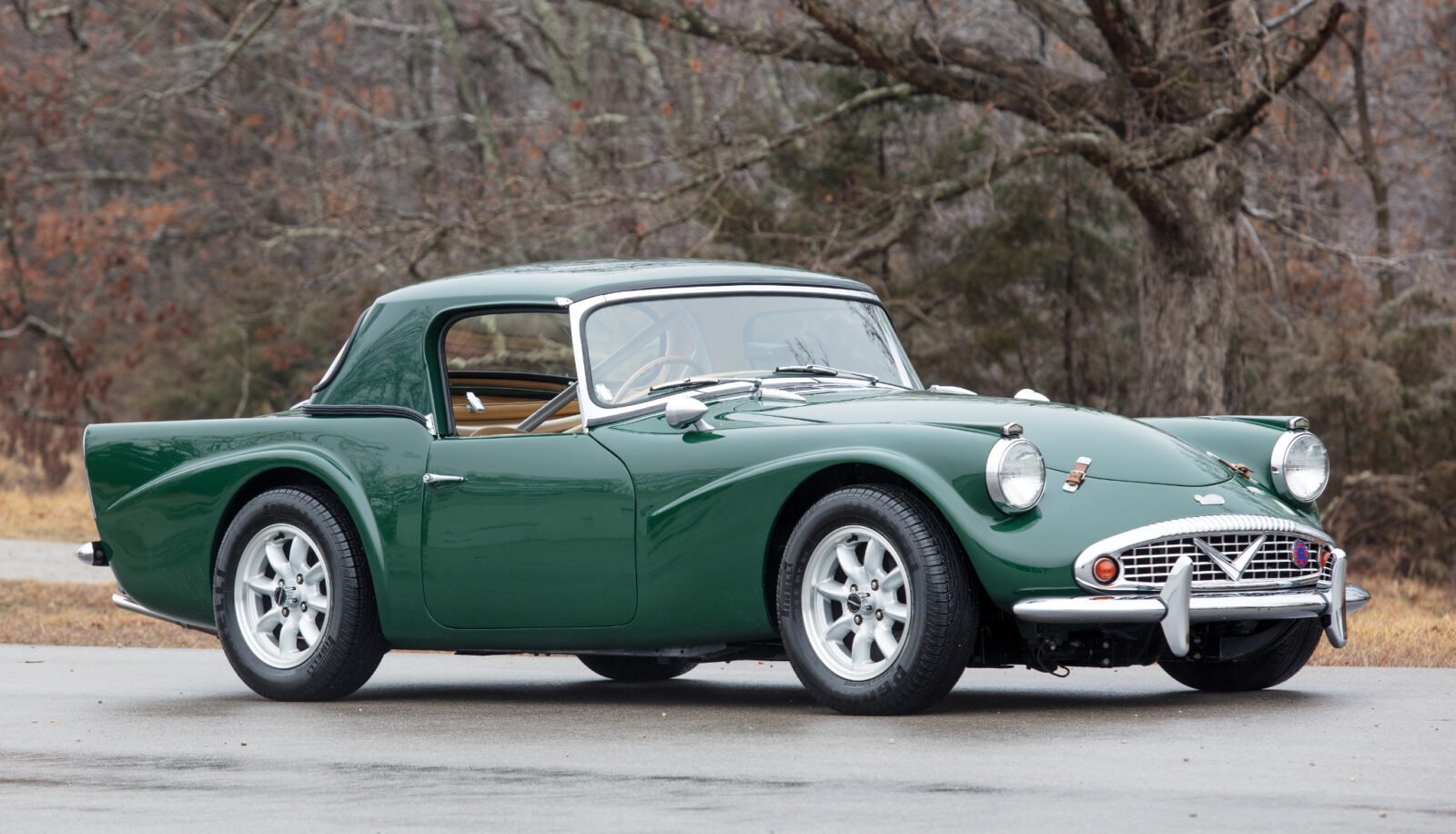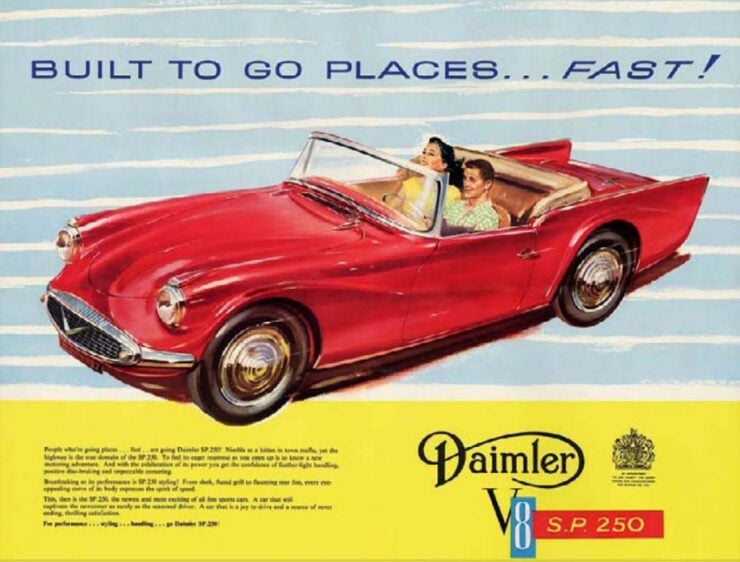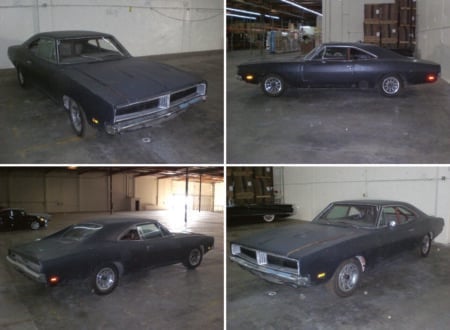At its debut at the 1959 New York Motor Show the Daimler “Dart” SP250 earned the unofficial title of being “The ugliest car of the show”. And to be sure the SP250’s looks are not its strong suit except for those of us with an eccentric sense of aesthetics.
These cars are rare, well designed, and hugely enjoyable to drive. The Daimler SP250 “Dart” might well be considered to be Britain’s “Corvette” it’s a car that delivers the traditional British Sports car driving experience on steroids, and for many it is superior to its peers for its quirky looks and unique all British V8 music-maker engine.
Fast Facts – The Daimler SP250 “Dart”
- The Daimler SP250 has been called the “British Corvette” due to the fact it likely took the inspiration for its fiberglass body and V8 engine from the American sports car.
- The quirky design of the SP250 has won it both fans and detractors in the decades since its introduction. The body was designed with aerodynamics in mind, however the front has been derisively been described as “droopy.”
- The British police famously used SP250s to chase and catch the cafe racer “Ton Up Boys” in the 1950s and 1960s, none of the other police vehicles of the time could match the speed of the 100+ mph motorcycles.
- Surviving examples of the Daimler SP250 have now become quite collectible, Jay Leno is a proud owner, and their prices seem to be steadily climbing in the classifieds and at auction.
In the Beginning
British car maker Daimler entered the 1950s as a company with an excellent past reputation, as an automaker favored by the British Royal Family, but as a company which was cash strapped and living in the doldrums of past glories.
It was a company that needed to pull a rabbit out of the hat in order to ensure not only its survival but its prosperity – and a V8 shaped rabbit seemed to be the perfect beating heart to install into a new range of car models with which to capture the imagination of not only British customers but – more importantly – a share in the booming United States automobile market.
Above Video: Jay Leno is doubtless the most famous fan of the SP250, in this video he tells the story of the car and there’s onboard driving footage with engine sound.
At that time Daimler was owned by the Birmingham Small Arms Company, an arms manufacturer which had made rifles for the British and colonial military and for civilian sporting shooters all over the world. This company is better known as “BSA” and remembered by many as a motorcycle manufacturer both of BSA and of Triumph bikes: BSA also owned Ariel motorcycles, Carbodies (who manufactured the iconic London taxi cabs), and prestige car maker Daimler.
Edward Turner, the creator of the Ariel Square Four engine and of the Triumph Speed Twin, became Chief Executive of the BSA group’s Automotive Division in 1956 and he was charged with the job of creating both a new V8 engine and cars to install them into. Turner had never designed a car before, and to assist him in this project was Jack Wickes, who had also never designed a car before, but there’s first time for everything.
Being the owner of a V8 Cadillac, Turner started his quest for design inspiration by studying the workshop manual and parts listing for a Cadillac V8 engine, and he had Jack Wickes do the same as they embarked on this new project. Their new design incorporated proven technology used in the Triumph and BSA motorcycle engines and it was intended that this new British V8 would power a four door saloon (sedan) which was designated the DN250, and a sports car which was called the SP250.
A British V8 to Upstage the Jaguar XK Six
The Daimler V8 engine that emerged from the work of the design team, who had been greatly assisted by Dr. J. N. H. Tait, was a five main bearing 90° V8 which featured a single chain-driven camshaft located high in the “V” of the engine actuating the valves by means of pushrods.
The block was of cast chrome-iron while the cylinder heads were of sand-cast high-tensile light alloy. The cylinder head design was loosely based on that of the Triumph Thunderbird motorcycle engines Turner had previously created, and incorporated part-hemispherical combustion chambers with two valves per cylinder, while pistons were aluminium alloy attached to steel connecting rods.
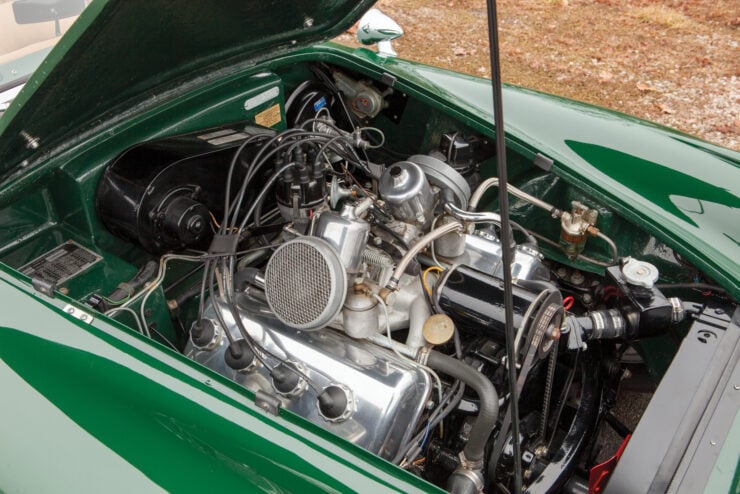

This all British V8 engine was made in two sizes: a 2.5 litre (2,548 cc) that weighed 419lb (190kg) dry, which was intended for both the DN250 sedan and the SP250 sports car; and a 4.5 litre which was physically slightly larger and weighed 498lb (226kg) dry which was intended for large Daimler limousines and which would compete against the Rolls-Royce V8 powered cars of the time.
So for Daimler the cars into which the smaller 2.5 litre V8 would be installed were intended to compete with the Jaguar cars installed with the much admired Jaguar XK six-cylinder engine.
The Daimler SP250 in Production
The Daimler SP250 was created on a bit of a “shoestring” budget – much in the same way that the Chevrolet Corvette was. The car was kept technologically conventional and used a body on chassis construction. The chassis was of a similar design to that used on the Triumph TR3 sports car, being a 14 gauge box section with central cruciform bracing.
This chassis seems to have been created with lightness in mind which on the original Daimler cars meant that it did not provide adequate stiffness, something that would be corrected on later models when the company was under Jaguar’s ownership.
This lack of rigidity gave the early SP250 the same teething problem as found on the early Chevrolet Corvettes – the doors could tend to come open while the cars were being driven. A problem not quite as dramatic as the passenger ejector seat fitted to James Bond’s Aston Martin DB5 in the movie “Goldfinger”, but still rather disconcerting – especially as the fault would tend to manifest itself when the car was being driven briskly.
To add insult to injury the bonnet (hood) could also pop open under the body flexing incurred during hard driving adding to the adrenaline rush of enthusiastic sports car driving in a not at all welcome way.
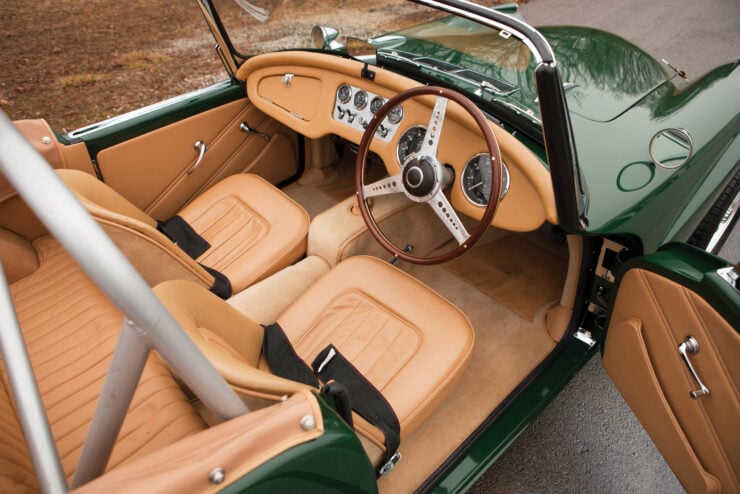

The suspension that formed part of this chassis incorporated an independent front with upper and lower arms, coil springs, and telescopic shock absorbers while at the rear were conventional semi-elliptic leaf springs with lever arm shock absorbers. The steering was by a cam and peg system which was and is not as good a choice as a proper rack and pinion.
The steering having no power assist it was heavy at parking speeds as one would expect regardless of whether it was cam and peg or rack and pinion. As originally fitted with a sensibly large steering wheel this heaviness poses no problem, and the older style larger steering wheel compliments the steering system giving a more precise feel in normal driving.
The brakes chosen for the SP250 were discs front and rear which was an excellent design choice. Disc brakes were only beginning to be used in passenger cars at that time and if they were used a typical setup was for discs at the front and drums at the rear. The four wheel disc brakes did not feature servo assistance, so although they provided efficient fade free braking the car requires the driver to have healthy leg muscles if an emergency stop was required.
In the 1950’s and into the 1960’s power brakes tended to lack feel and so were normally not preferred on sports cars: the absence of the power assist providing the driver with very direct feel for the brakes.
Daimler were on a tight budget in bringing the SP250 into production and their expectations had to be that the car would make relatively low production numbers. So, being in much the same situation as General Motors when they built the first Corvettes, Daimler decided to go with a fibreglass body just as Chevrolet had done. The tooling cost for fibreglass was one tenth the price compared with a steel body and it came with the added benefits of being light and rust free.
Daimler decided to christen their new sports car the “Daimler Dart” and that would be the name that would tend to stick to the car despite the fact that the car was forced to drop the name “Dart” at the time it made its 1959 American debut. US carmaker Dodge already had an established model named the “Dodge Dart” and they promptly took legal action to prevent Daimler using the “Dart” name.
Beauty is in the Eye of the Beholder
This car was to have almost a wedge shape with low front end and flowing lines up to the graceful rear fins, something which was probably intended for aerodynamic stability and to look attractive to Americans. Arguably the design achieved the desired aerodynamic effect, but the problem with the need for the car to be attractive to Americans is that the design team at Daimler were not able to come up with one.
What emerged as the production car was something that was either “love it” or ‘hate it”: with the vast majority of people on the “hate it” side. Just for the record I’m one of the few in the “love it” camp although I will still confess that the planned successor for the SP250 – the Sir William Lyons designed SP252 – was a far prettier car.
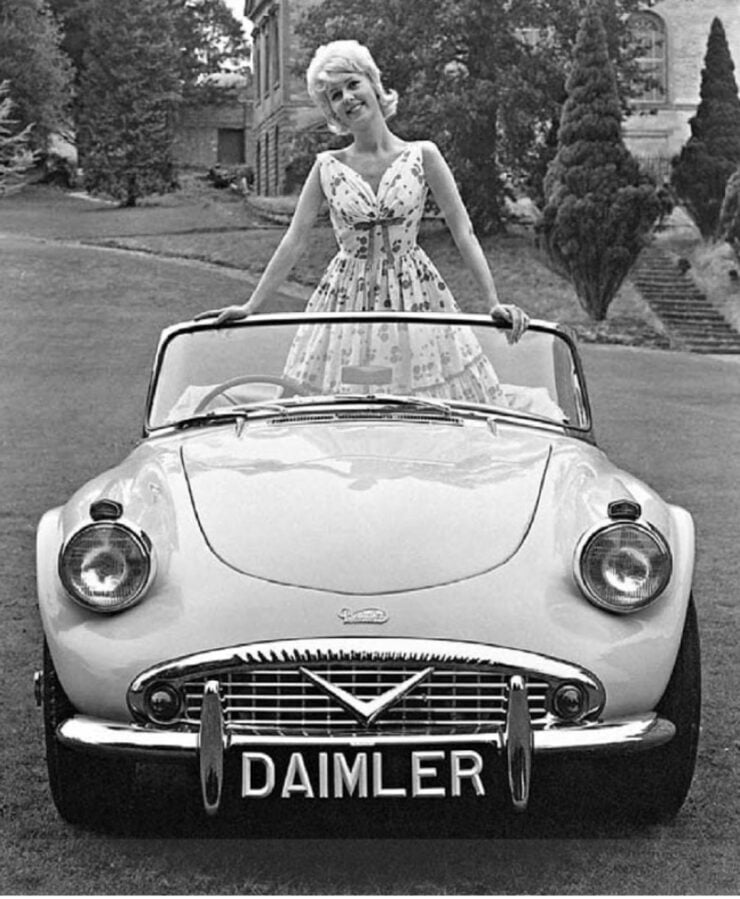

Initially launched in the United States on 4th April 1959 as the “Daimler Dart” at the New York Motor Show it earned the dubious unofficial award for “Ugliest car of the show”. So it was pretty much received in the same way as the controversial Citroën DS when that car was first introduced.
The other aspect of the car which Americans decided was ugly was the name. Dodge already had a model called the “Dodge Dart” and so they objected to Daimler also using that name, with the result that Daimler simply re-named the car the Daimler SP250.
All that being said, the Daimler SP250 “Dart” has a purposeful, almost aggressive look, and it is aerodynamically sound with its low front end and semi-wedge shape providing a good down-force on the car, helping to make it stable at speed.
Production and Models
Production of the original Turner and Wickes designed Daimler SP250 began in 1959. In 1960 Daimler was purchased from the Birmingham Small Arms Company by Jaguar. Jaguar purchased the company primarily to acquire its manufacturing facility and skilled workforce to use to build Jaguars, although they continued production of Daimler cars.
Jaguar’s engineers assessed the SP250 as being in need of refining and in particular the chassis was subjected to significant modification to bring it up to Jaguar’s standard. The original 1959-1960 cars are now referred to as “A” specification or “A-Spec”.
Jaguar’s engineers assessed the SP250 as being in need of significant chassis stiffening. They had discovered that if they pressed down hard on the rear wing the car’s door gap could be made to grow by up to 8mm. Similarly the windscreen pillars could be made to flex an inch by hand pressure.
To rectify the car’s shortcomings Jaguar’s engineers fitted a steel box section hoop to connect the car’s “A” pillars together, added reinforcements to the “B” pillars, and installed two steel outrigger sill beams along each side of the chassis between the wheels, and other strategically placed strengthening reinforcements.
These things solved the impromptu door opening tendencies of the car while making it rather better to drive. These Jaguar improved cars are known as the “B” specification cars and were in production from 1960-1963. They were followed by the more luxuriously appointed “C” specification cars from 1963 until the end of production in 1964.
The three variants of the SP250 are subtly different. The “A” specification cars were not fitted with bumpers as standard equipment but instead at the front had chrome “whiskers” that extended from the grill, while at the back were two vertical bumper over-riders.
The “B” specification cars did not come with either whiskers at the front nor bumpers at the rear as standard, but like the “A” specification model could be ordered with bumpers as an optional extra. These cars featured an adjustable steering column. The “C” specification cars also did not come with bumpers as standard equipment but they featured a heater/demister, cigar lighter, and trickle charger.
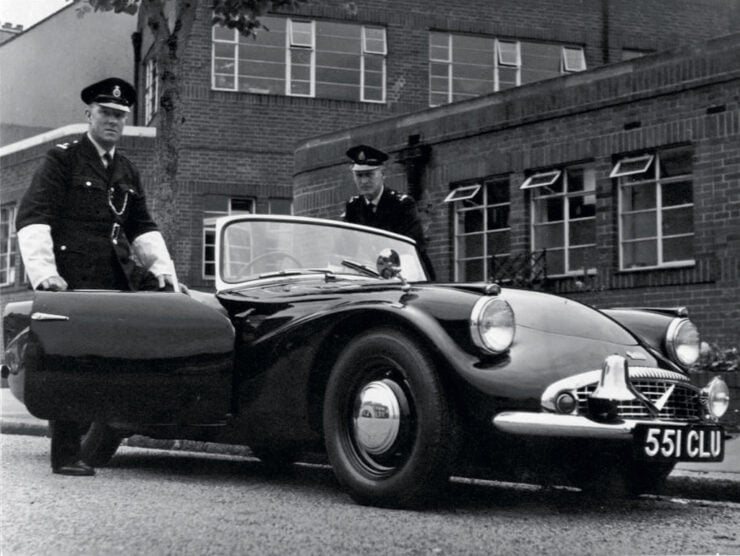

An interesting variant of the SP250 were the special order cars purchased by the London Metropolitan Police beginning in 1959. These cars were all painted black and were fitted with three speed automatic transmissions. Sports car enthusiasts might be horrified at the sacrilege of installing an automatic box in a sports car but the police were interested in practicality.
The automatic gearbox was not only easier for officers to use but it also protected the transmission and engine for day in day out fast acceleration needed to catch the motorcycle “Cafe Racer” boys who were essentially road racing on public roads, commonly on motorcycles designed by Edward Turner and Jack Wickes.
The SP250 was one of few cars that could actually catch up with them so they could be treated to a ticket to the “policeman’s ball” and perhaps helped to live a little longer – or at least keep a more watchful eye out for the little black Daimler sports cars.
Buying a Daimler SP250
Before launching into the purchase of a Daimler SP250 the best advice is to get connected with one of the owner’s clubs and do your research so you have a good working knowledge of the cars, and through the club members you obtain practical knowledge and a network of knowledgeable friends.
As you embark on your search for the right car scan the auction sites and classic car sales advertisements to get a feel for what you might expect to pay for cars in various levels of good preservation – or lack thereof. Consider not only your financial budget, but also you time budget in terms of how much time can you expect to invest in this car, especially if you are intending to purchase a “project” car. Many are those who purchase a project car to restore but who find they are unable to complete it.
As you begin to assess potential purchases remember that, although the body panels are made of fibreglass, that everything that holds that fibreglass in place – the car itself – is made of steel, and that steel was only subject to the rust proofing typical of many car makers of 50-60 years ago – remembering that back then we said that cars came “rust free” – i.e. the manufacturer gave you the rust for nothing. Also remember that some of that steel will be visible – and some not. That being said it is essential to do a lot of your assessment of a potential purchase from the underside of the car – get it up on a workshop stand so you can have a close look at the underside in undistracted comfort.
On the SP250 places to look for corrosion of the chassis are the front cross tube, front suspension turrets (replacements available but installation requires removal of the body shell), rear front spring hangars, outriggers, and rear suspension mounting points. Pay particular attention to the crossmember behind the rear axle and the reinforcing beams behind it; if repairs are needed it can be a complex task.
Mounting brackets for the lower front wishbones can show cracking of the welds. Repair of corrosion in the chassis may require the bodyshell to be removed which involves fifty sets of nuts and bolts to undo – almost certainly requiring liberal quantities of WD40 and possibly an occasional strategic whack with an impact driver.
Then there are the steel parts that were embedded into fibreglass panels to secure them to the chassis or other parts of the bodywork. In the nose section you will find two mounted either side of the radiator that secure the fibreglass to the front chassis tube. If these are corroded the nose will not be properly supported and when it flexes under load the bonnet/hood might just decide to jump up like Casper the Friendly Ghost and cause you a moment of memorable terror – because we all understand that what you can’t see can hurt you.
There are also embedded steel parts for the bonnet/hood catch, either side of the engine bay, seat runner fastening points, and B and C specification cars will also have embedded parts where the hoop brace at the “A” pillar passes through the fibreglass floor and attaches to the chassis outriggers.
The fibreglass itself might not rust but it can be subject to cracking especially in areas that have been subject to flexing, and areas subject to rough handling such as the boot/trunk lid having been carelessly slammed shut on a protruding piece of hard luggage – if some people will try to close a bursting suitcase by sitting on it then you can assume that there are those who might similarly try to sit on the fibreglass boot lid to force it to shut – and they will with near certainty not notice any damage done. Hopefully the car you are considering has not had such ministrations, but check thoroughly all over the body and underneath for sixty years worth of wear and tear.
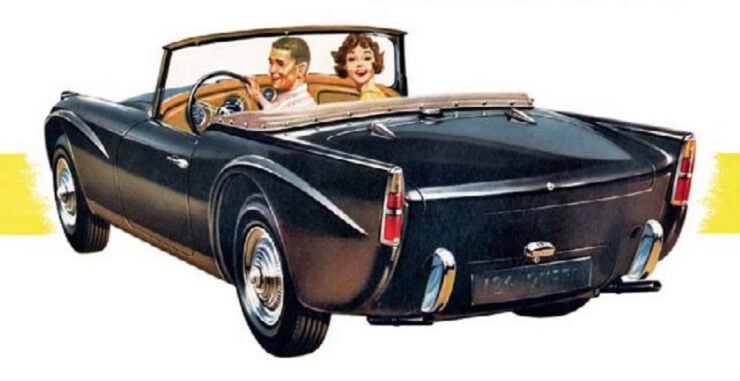

The suspension may show signs of wear in the trunnions – typically caused by lack of regular greasing. These can prove to be costly to repair.
Fibreglass might not rust like steel but it does tend to deteriorate with age like most plastics. It is possible to reinforce an old fibreglass body shell by applying new fibreglass underneath the original one to provide strengthening and support.
Checking the engine and transmission is much the same as for any classic car of the post war decades. The alloy heads make correct corrosion inhibitor a requirement and if the car has not had this maintained then cylinder head corrosion must be expected, signs of dirty white oil “mayonaisse” in the cooling system means trouble. Oil pressure should be 40psi at 30mph in top gear. These engines acquired a reputation for wearing in the heavier Daimler V8 250 but not usually in the lightweight SP250.
The gearbox was not a standard Triumph TR3 unit but was built specifically for the SP250. Despite that its crown wheel and pinion were not engineered fully up to the task of delivering V8 power to the back wheels when the driver decided to drive his sports car like a sports car.
Improving Your Daimler SP250
The original steering of the SP250 can definitely stand improvement and changing it over to a rack and pinion is a good way to accomplish that. The system from the Triumph Spitfire is the preferred unit. Beware of a car that has already had a conversion done to ensure it was done expertly. The steering is something that must not be compromised on, lives depend on it never failing. If you do choose to install a suitable rack and pinion system you will need to also install an electric radiator fan – which will also improve cooling efficiency nicely.
Installation of a servo assist for the brakes is another worthwhile improvement.
The rear lever arm shock absorbers can be replaced with telescopic ones, and such a conversion will improve the locating of the rear axle.
The original gearbox can have a traditional electric overdrive fitted and this makes highway speed cruising more pleasant and economical.
The fitting of an Austin-Healey 3000 diaphragm spring clutch will improve reliability and reduce the effort required to operate the clutch.
As mentioned previously, some of these cars were made with an automatic transmission, and the Jaguar made Daimler V8 250 was also offered with an automatic transmission. So if you prefer this it can be a good choice for your car – it is likely to improve reliability of the transmission which was one of the reasons the British police SP250’s were so fitted.
Daimler SP250 “Dart” Specifications
- Chassis and Body: Box section 14 gauge steel ladder chassis with “X” cruciform central bracing. Design very similar to that used on the Triumph TR3. Fibreglass body over steel frame components, including steel parts embedded into the fibreglass body for mounting of bonnet (hood) attachments.
- Suspension, Steering and Brakes: Front suspension fully independent by upper and lower “A” arms with coil springs and telescopic shock absorbers. Rear suspension by semi-elliptic leaf springs and lever arm shock absorbers. Steering by cam and peg. Brakes, hydraulic Girling discs front and rear. No power assistance on either steering or brakes.
- Engine: 2.5 litre (2547cc) OHV V8 with two pushrod actuated valves per cylinder, these valves having double springs. Single dynamically balanced centrally mounted camshaft. Cast iron cylinder block, high tensile aluminium cylinder heads featuring hardened valves (making the engine suitable for use with unleaded fuel). Power 140bhp @ 5,800rpm, torque 155lb/ft @ 3,600rpm. Twin SU carburettors and SU electric fuel pump.
- Pressurised cooling system with fan, thermostat and water pump.
- Ignition by coil and distributor with automatic advance/retard.
- Transmission: Four speed manual gearbox with synchromesh on top three gears, this gearbox being loosely based on the Triumph TR3 unit. Rear axle; hypoid bevel with ratio of 3.8:1.
- Optional three speed automatic (originally not available except for the police specification cars and US export cars).
- Performance: Standing to 60mph in 9.0 seconds. Top speed of 124mph.
- Optional Equipment: The option list is quite extensive for the simple reason that when importing cars into the United States the standard equipment was taxed, whereas optional equipment was not. Options included heater/demister, windscreen washers, seat belts, bumpers for front and rear, hard top, fog lights, adjustable steering column (standard on B and C specification cars), wire wheels, whitewall tyres, electric overdrive.
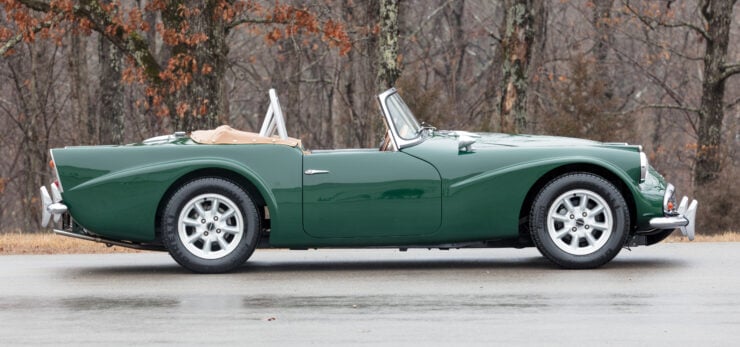

Conclusion
The Daimler SP250 “Dart” is a car with a quite unique, albeit quirky, appearance. That being said it delivers a purist British sports car driving experience with an important something extra: that something extra being a genuine all British Edward Turner and Jack Wickes V8 engine thumping away as its beating heart. These are not a car for everyone, but if the SP250 has grabbed your attention then it is pretty certain that nothing less will do.
The unique nature of this car means that, despite them being quite rare, they are still able to be found for reasonable amounts of money. And if you are looking at purchasing one as a restoration project you can expect that once complete you should have a good investment quality car that will return to you the money and labour you’ve expended to restore it to its former glory – or better than its former glory.
These are one of the most desirable of all the British sports cars of the 1950’s and 1960’s, they ooze character, and accelerating hard that V8 will sing a song to send shivers up your spine.
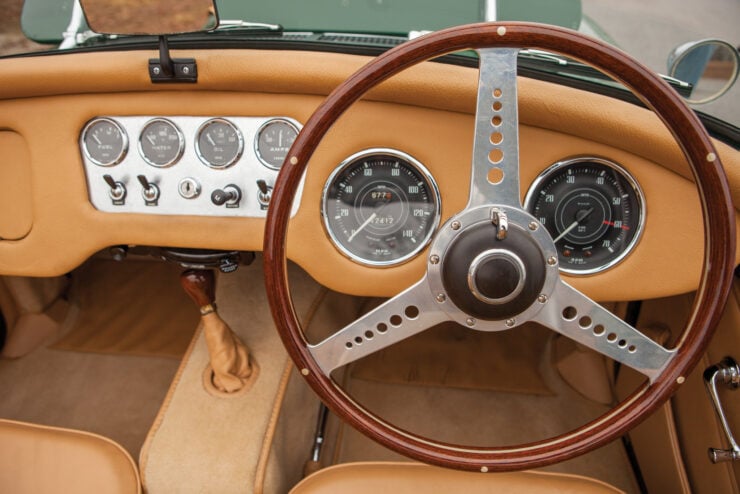
Picture Credits: Daimler-Jaguar, RM Sotheby’s (Daniel Rockafellow).

